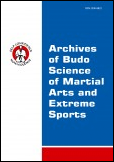2016, Volume 12, Issue 1
Does pain always accompany martial arts? The measurement of strategies coping with pain by taekwondo athletes
Dorota Ortenburger1, Jacek Wąsik1, Małgorzata Szerla2, Tomasz Góra1
1Institute of Physical Education, Tourism and Physiotherapy, Jan Dlugosz University in Czestochowa, Czestochowa, Poland
2Department of Emergency Medicine, The Faculty of Medicine and Health Science, Jan Kochanowski University, Kielce, Poland
Author for correspondence: Jacek Wąsik; Institute of Physical Education, Tourism and Physiotherapy, Jan Dlugosz University in Czestochowa, Czestochowa, Poland; email: jwasik[at]konto.pl
Full text
Abstract
Background and Study Aim: In the light of the literature on health psychology individuals are active processors of information and not passive reactors. The general aim the research is knowledge about the strategies of copying with pain used by taekwondo athletes.
Material and Methods: Fourty seven taekwondo athletes participated in the study (14 female, 33 male), aged between 16 and 45 (average 25.1 7±9.73 years). Research tools: Questionnaires used in health psychology were applied in the research; Coping Strategies Questionnaire and Feeling of Personal Competence Scale. Additionally, in the presented research the data were gathered with the use of self-elaborated questionnaire. The regression technique was used.
Results: The conducted research shows that taekwondo athletes use the following strategies of copying with pain: revaluation (M = 27.94 ±6.10), distracting attention (M= 25.68 ±7.12), behavioural strategies (M = 24.49 ±5.97), catastrophizing (M= 4.51 ±8.16) and mixed strategies will combine cognitive and behavioural strategies that distract attention. Average values of how the examined persons can subjectively control negative feelings caused by pain are M = 3.62 ±1.15 was observed. The correlations between the strategies coping with pain and feeling personal competence were observed (p<0.05).
Conclusions: In the examined taekwondo group relations between the adaptative, active strategies: revaluation and distracting attention and feeling of personal competence were observed. A very low degree of catastrophizing was observed. Revaluation (positive predictor) and catastrophizing (negative predictor) explained part of the variance feeling of personal competence level R2 = 0.52; p<0.01.
Key words: combat sports, possibility of action, psychological measurement, sports psychology





